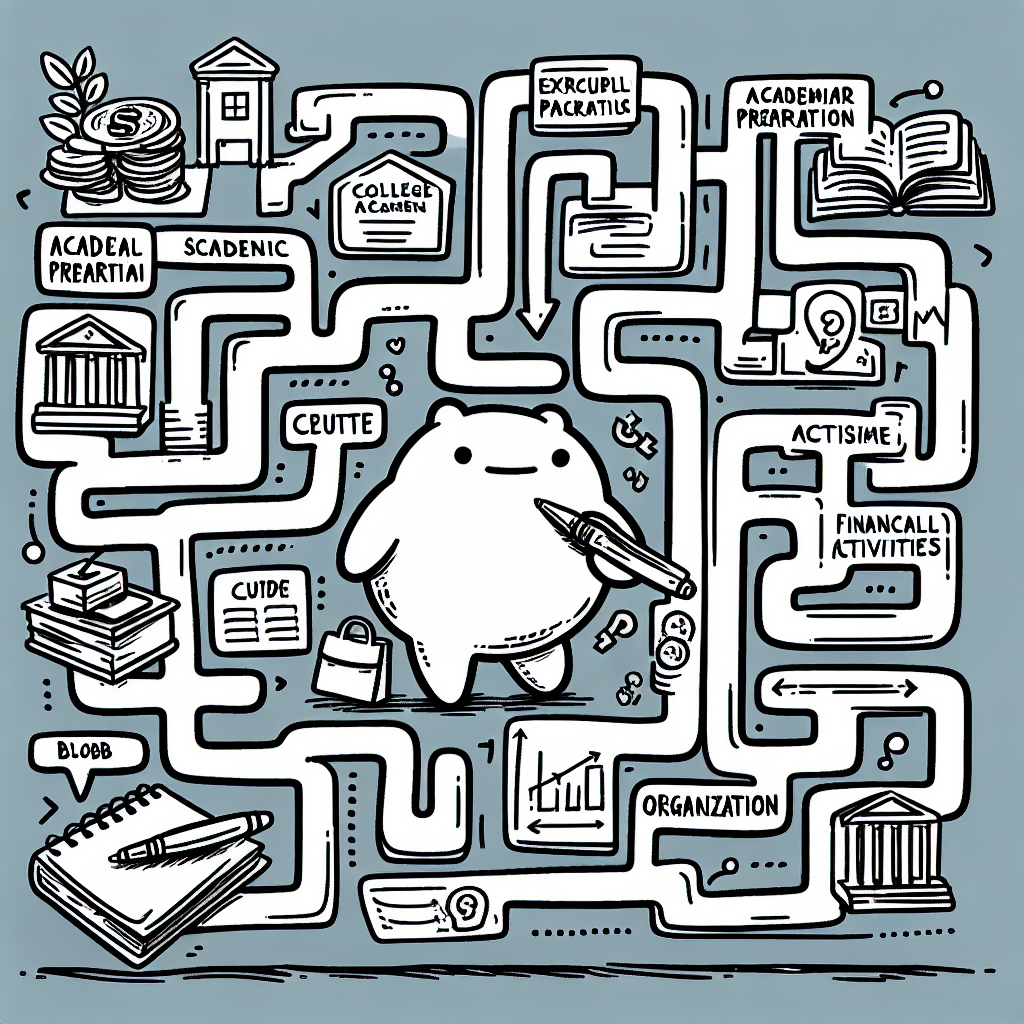Introduction
The journey of learning how to get into college is shaped by a range of academic, personal, and financial factors. From building a strong academic record to preparing for standardized tests and writing compelling application essays, each step plays a role in determining college admissions outcomes. Financial planning and personal development also influence the process, adding complexity and importance to early preparation.
This guide provides a detailed roadmap for students, parents, and educators to navigate the college application process successfully. By breaking down each phase and highlighting key strategies, it aims to make the path to college clearer and more manageable for all involved.

Understanding College Admission Criteria
Academic Foundations
GPA (Grade Point Average)
A strong GPA is one of the most important components when considering how to get into college. Admissions officers look at your GPA to assess your academic consistency and ability to handle challenging coursework. A high GPA over all four years of high school signals strong work ethic and intellectual discipline.
Colleges evaluate both weighted and unweighted GPAs. An unweighted GPA uses a 4.0 scale and treats all courses equally, while a weighted GPA accounts for the difficulty of classes, such as honors, AP, or IB courses, often on a 5.0 scale. Understanding how your school calculates GPA and how colleges interpret it can help you set realistic academic goals.
Standardized Test Scores (SAT/ACT)
Standardized tests like the SAT and ACT have traditionally played a significant role in how to get into college, though many schools now have test-optional policies. Still, strong scores can enhance your application, especially if your GPA is lower or you're applying to competitive programs.
To improve your scores, consider using prep books, online practice tests, or enrolling in a test prep course. Planning your test schedule early allows time for retakes, which can boost your final results. Be sure to check each college’s testing requirements and deadlines.
High School Coursework
Admissions committees look for students who challenge themselves academically. Enrolling in rigorous courses—such as Advanced Placement (AP), International Baccalaureate (IB), dual enrollment, and honors classes—demonstrates your readiness for college-level work.
Completing core requirements in math, science, English, social studies, and foreign language is essential. Electives that align with your intended major or interests can also strengthen your application and show your commitment to a particular field.
Beyond the Classroom
Teacher Recommendations
Teacher recommendations are a key part of how to get into college, offering insight into your academic character and classroom engagement. Teachers who know you well can speak to your strengths, work ethic, and potential for success.
To secure strong recommendations, build relationships with teachers early, participate actively in class, and communicate your goals. Provide recommenders with a resume or summary of your achievements to help them write a personalized letter.
Extracurricular Activities
Colleges value applicants who have shown commitment and leadership outside the classroom. Rather than joining many clubs, focus on a few meaningful activities where you can take on responsibilities and show growth over time.
Extracurriculars that align with your academic interests or personal story can enhance your application. Whether it's sports, music, volunteering, or internships, consistency and depth matter more than quantity.
Personal Essays and Statements
Personal essays give you the chance to express who you are beyond your grades and test scores. Writing a compelling narrative that highlights your individuality, perseverance, or unique experiences is an essential part of how to get into college.
Common prompts include describing a challenge you’ve overcome, an experience that shaped you, or your reasons for choosing a particular college or major. Be authentic, stay focused, and revise carefully to ensure your essay is clear and impactful.
Interviews
Some colleges require or recommend interviews as part of the admissions process. Interviews allow applicants to showcase their personality, clarify their interests, and demonstrate enthusiasm about the school.
To prepare, research the college thoroughly, practice common interview questions, and have thoughtful questions ready to ask. Dress appropriately and be punctual to make a positive impression.

Financial and Social Considerations
Understanding the financial and social factors that influence how to get into college is essential for students and families making informed decisions. Affordability, cost considerations, and access to financial aid significantly impact college enrollment rates and options.
College Affordability and Perceptions
Perceptions of affordability play a major role in whether students pursue higher education. According to the National Center for Education Statistics, students who believe their families can afford college are more likely to enroll within three years of high school graduation. This perception can shape a student's motivation and willingness to apply.
Cost as a Decision Factor
Cost is one of the most influential factors in the college decision-making process. Data from the NCES shows that over 95% of students consider cost to be either a "somewhat important" or "very important" factor when choosing a college. However, understanding the difference between a college's sticker price and the actual net price is critical. Sticker price refers to the published tuition and fees, while net price accounts for grants, scholarships, and other aid that reduce the total cost.
To estimate the real cost of attendance, students can use net price calculators available on college websites. Completing the FAFSA (Free Application for Federal Student Aid) and, when applicable, the CSS Profile allows students to access federal and institutional financial aid.
Financial Aid and Counseling Support
School counselors play a key role in guiding students through the financial aid process. As reported by the NCES, students who met with a counselor about financial aid were more likely to receive need-based grants. Engaging with counselors early in high school can help students stay on track with important deadlines and opportunities.
A typical timeline includes submitting the FAFSA and applying for scholarships in the fall of senior year. Early preparation ensures students maximize their chances of securing financial support, making college more accessible and helping them understand how to get into college with fewer financial barriers.

Admission Pathways and Planning Strategies
Types of Colleges and Admission Policies
Understanding the types of colleges is an important step in learning how to get into college. Community colleges typically offer two-year associate degrees and serve as a cost-effective pathway to a four-year institution. Liberal arts colleges emphasize broad-based undergraduate education in the humanities and sciences. Research universities offer a wide range of undergraduate and graduate programs and focus heavily on scholarly research. Technical schools provide specialized training in areas like engineering, health sciences, and skilled trades, often leading directly to employment.
Colleges also differ in their admission policies. Early decision is a binding agreement where students commit to attending if accepted. Early action is non-binding, allowing students to apply early and receive a decision without obligation. Regular decision is the standard application timeline, usually with deadlines in January. Rolling admissions review applications as they come in, offering decisions on a rolling basis until spaces are filled.
Building a Balanced College List
To improve your chances of getting into college, it's smart to create a balanced list of reach, match, and safety schools. Reach schools are institutions where your academic profile falls below the average admitted student. Match schools are those where your qualifications closely align with admitted students. Safety schools are ones where your credentials exceed the typical applicant.
Using college search tools like the College Board’s BigFuture or Naviance can help you assess your fit. Rankings can offer insights, but they should be used as one of many factors, not the sole determinant.
Application Planning Timeline
9th Grade
Focus on establishing strong academic habits and exploring a variety of extracurricular interests. These early steps lay the foundation for later achievements.
10th Grade
Take the PSAT to gain early test-taking experience. Continue building extracurricular involvement by taking on more responsibility or leadership roles.
11th Grade
Begin preparing for standardized tests like the SAT or ACT. Schedule meetings with your school counselor to start narrowing down your college list. Attend college fairs and campus tours if possible.
12th Grade
Finalize your college list and complete all application materials, including essays and recommendation letters. Submit the FAFSA and any other required financial aid forms on time to ensure eligibility for aid.
By following these admission pathways and planning strategies, students can better position themselves in the competitive process of how to get into college.

Meeting the Metrics – Who Gets In?
Understanding how to get into college, particularly highly selective institutions, requires a clear view of the academic and extracurricular benchmarks that applicants must meet. The National Center for Education Statistics' report "Making the Cut" sheds light on who actually meets these criteria.
The report found that meeting selective college admissions standards typically involves a combination of strong GPA, high SAT or ACT scores, completion of rigorous coursework (such as honors or Advanced Placement classes), strong teacher recommendations, and meaningful involvement in extracurricular activities. These combined indicators form the academic and personal profile that selective colleges seek.
However, "Making the Cut" also highlights significant demographic disparities in who meets these benchmarks. Students from higher-income backgrounds and those attending well-resourced schools are more likely to access advanced courses and receive robust academic guidance. In contrast, students from underserved communities often face barriers to meeting the same expectations, which affects their chances of admission.
Implications for Students
For students learning how to get into college, especially selective ones, the findings emphasize the importance of evaluating where they stand in terms of GPA, test scores, and course rigor early in high school. Identifying gaps early can help students focus on areas for academic improvement or seek out opportunities for leadership and extracurricular engagement.
Implications for Educators
Educators play a key role in helping students navigate how to get into college. Ensuring equitable access to advanced coursework and extracurricular opportunities is crucial. Academic advisors and counselors should prioritize early intervention, helping students build a competitive profile before senior year. This includes guiding course selection, supporting test preparation, and encouraging involvement in meaningful activities.

Application Process Essentials
Submitting a Strong Application
When learning how to get into college, submitting a strong application is critical. Start by paying close attention to all deadlines. Missing even one can disqualify your application. Make sure your transcripts are requested and sent on time, and that any required supplementary materials—like essays, portfolios, or test scores—are submitted in the correct format.
Students typically apply through platforms like the Common App, the Coalition App, or school-specific portals. The Common App is widely accepted and allows you to apply to multiple colleges with one application. The Coalition App is similar but includes features designed to support underrepresented students. Some colleges require you to use their own portals, so always check each school's application requirements.
Demonstrating Interest
Demonstrating interest can influence admissions decisions, especially at selective colleges. Visiting campuses in person, if possible, or taking part in virtual tours and information sessions shows that you're engaged. These actions often get logged by admissions offices.
You can also demonstrate interest by emailing admissions officers with thoughtful questions or attending college fairs where school representatives are present. These interactions help build a record that you’re genuinely interested in the institution, which can support your overall application.
Letters of Recommendation
Letters of recommendation are another key part of how to get into college. Choose teachers or mentors who know you well and can speak to your academic strengths and personal character. Ask them early—ideally at the end of your junior year or the very beginning of your senior year—to give them ample time.
Provide your recommenders with helpful context, such as a resume or a list of your achievements and goals. Clear timelines and polite reminders can ensure that your letters are submitted before the deadline, completing your application package effectively.

Navigating Access and Equity
Understanding how to get into college involves not only meeting academic requirements but also overcoming systemic barriers that can limit equal opportunity. Access to higher education is shaped by a range of factors, including socioeconomic status, race, and parental education levels. These disparities are especially evident among first-generation college students and underrepresented groups, who often face additional challenges in navigating the college admissions process.
The Access to Postsecondary Education for the 1992 High School Graduates report highlights the significance of early college awareness and preparation. It shows that students who start planning for college early—by taking rigorous courses, preparing for standardized tests, and understanding application procedures—are more likely to enroll in postsecondary education. However, access to this preparatory information is not distributed equally.
To address these gaps, several programs have been developed to support students from disadvantaged backgrounds. Federal initiatives like TRIO and Upward Bound provide academic tutoring, counseling, and college readiness workshops. These programs aim to bridge the information and preparation gap for students who may lack resources at home or in their schools.
Additionally, nonprofit organizations such as QuestBridge connect high-achieving, low-income students with elite colleges and universities. By offering mentorship, application guidance, and scholarship opportunities, QuestBridge helps level the playing field in the competitive admissions landscape.
Efforts like these are crucial in making the process of how to get into college more equitable for all students, regardless of their background.

Conclusion
Key Takeaways
- Successful college admission is built on a foundation of academic readiness, extracurricular involvement, and financial planning.
- Early and consistent preparation, along with informed support, make a significant difference in how to get into college.
Final Recommendations
- Start early and stay organized throughout the entire college application process.
- Seek guidance from school counselors and mentors who can provide insight on how to get into college effectively.
- Focus on finding the right fit for your goals and interests, rather than solely pursuing prestige.
Additional Resources
- Making the Cut: Who Meets Highly Selective College Entrance Criteria?
- High School Counseling and College Financial Aid
- College Affordability Views and College Enrollment
- Factors That Influence Student College Choice
- Access to Postsecondary Education for the 1992 High School Graduates














